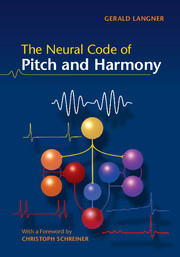Book contents
- Frontmatter
- Contents
- Preface
- Foreword
- 1 Historical aspects of harmony
- 2 Sound and periodicity
- 3 The discovery of the missing fundamental
- 4 The pitch puzzle
- 5 The auditory time constant
- 6 Pathways of hearing
- 7 Periodicity coding in the brainstem
- 8 Periodicity coding in the midbrain
- 9 Theories of periodicity coding
- 10 Periodotopy
- 11 The neural code of harmony
- 12 The oscillating brain
- References
- Index
3 - The discovery of the missing fundamental
Published online by Cambridge University Press: 05 May 2015
- Frontmatter
- Contents
- Preface
- Foreword
- 1 Historical aspects of harmony
- 2 Sound and periodicity
- 3 The discovery of the missing fundamental
- 4 The pitch puzzle
- 5 The auditory time constant
- 6 Pathways of hearing
- 7 Periodicity coding in the brainstem
- 8 Periodicity coding in the midbrain
- 9 Theories of periodicity coding
- 10 Periodotopy
- 11 The neural code of harmony
- 12 The oscillating brain
- References
- Index
Summary
‘Wodurch kannüber die Frage, was zueinem Tone gehöre, entschieden werden, als eben durch das Ohr?’
‘How else can the question of what belongs to a tone be decided, than by the ear?’
(August Seebeck, Über die Definition des Tones, 1844)The sound of sirens
At the beginning of the nineteenth century, the field of experimental acoustics was floundering. One of the main problems at this time was a purely technical one – there was no easy method to vary the frequency of tones in a precise and reproducible way. Experimental research relied on the use of tuning forks or oscillating strings, or on simple musical instruments such as flutes and, in practice, these methods were imprecise and somewhat difficult to handle. Therefore no great progress could be made in understanding the essence and perception of tones.
A turning point for acoustical research came with the invention of the siren as a scientific instrument. Originally introduced by Charles Caignard de la Tour (1819), the siren made it possible to generate tones of a precise and quantifiable frequency. It was this new-found accuracy and reproducibility in tone production which opened the door for acoustics to become both an independent and an exact science.
Several prominent researchers invented their own versions of the siren for acoustical experimentation – one of them, a young German physicist named August Seebeck (Fig. 3.1), constructed a siren which incorporated a number of improvements over Caignard's original design (Fig. 3.2 shows a simple version). It allowed the creation of continuous, clear, steady tones over a large range of pitches. The tones were easily reproducible and could also be quantitatively defined by means of a mechanical counter. Moreover, since the tones were related to the geometric arrangement of the holes on a rotating disc, octaves and other harmonic intervals could be simultaneously generated with high precision.
- Type
- Chapter
- Information
- The Neural Code of Pitch and Harmony , pp. 24 - 34Publisher: Cambridge University PressPrint publication year: 2015



